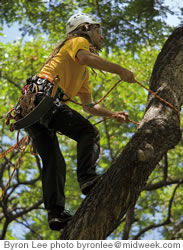Up A Tree Without A Ladder
Arborists gather in Honolulu for the world tree-climbing championship, and climbers dazzle with their Spider-Man-like skills

By .(JavaScript must be enabled to view this email address)
E-mail this story | Print this page | Archive | RSS

|
It’s not every day that you see bodies dangling from trees at UH-Manoa. But July 28 was special and adventure was in the air as 2,000 arborists from around the globe descended on the campus. They had arrived for the International Society of Arboriculture’s annual conference. Don’t let the collegiate tone of those words fool you - ISA boasts one of the world’s more radical events, the International Tree Climbing Championship.
Two monkeypod trees, equipped with a dozen ropes each, offered visitors to the event firsthand experience in the art of tree climbing. After donning hard hats, a climbing saddle and gloves, they were hooked into one of the ropes, and relying on a system of knots to hold them securely, they inched their way up with kicks, pushes, pulls and thrusts. Some gave up after just a couple of feet while others awkwardly jerked their way up as high as 20 feet.
“When I train climbers - and I’m not exaggerating - at least half can’t get 10 feet off the ground,” revealed Kevin Eckert, a local consulting arborist and the conference chair.
The real action was around the corner. A mammoth baobab, majestically tall with a trunk wider than an African elephant, was surrounded by a large audience craning their necks back to watch the flurry of action in its branches. It was the Work Climb event, one of five professional climbing events scheduled for the day.
“The tree-climbing championship is like the Olympics in that contestants have to qualify,” explained Eckert. “All around the world, different chapters have preliminary competitions. The winners of those competitions are here in Hawaii, which is part of the Western chapter along with California, Nevada and Arizona.
“Basically, using proper equipment, safety techniques, innovation, ability, skill and knowledge, contestants compete in a number of events. Like in gymnastics, they are scored on technique, smoothness and speed, but speed is not of the essence.”

|
Hawaii won the bid to host this year’s competition, attracting the most contestants yet - 37 men and 19 women. All are professional arborists, meaning that one of their many skills is navigating their way through giant trees to trim them.
“The Work Climb has stations simulating working in a tree,” Eckert elaborated. “One of those stations is a long limb. They have to set their rope and go out on the limb without putting any weight on it. What if the limb had a defect, you don’t want to break it.”
If the limb drops more than six inches, a “plumb bob” hanging from the end of the branch will hit a metal buzzer below, costing points.
At another station contestants toss a stick of wood at a target on the ground. At another, they locate a pole pruner and then, securing themselves in the branches using a lanyard, they reach out to ring a bell with the end of the pole.
At each station they ring a bell to signify completion of the task, thus earning points. Unsafe practices lose them points and possible disqualification. For example, hitting the bell with the wrong end of the pole costs them points, and dropping any of their tools from the tree automatically disqualifies them.
Technicians are stationed in the tree and on the ground in case of emergency, and at least five judges on the ground are watching each climber.
“On the job there’s a lot of falls - more than most people think,” noted Eckert. “I’ve had a couple of friends who have been killed, and some have been very seriously injured, and it’s always because of stupid mistakes. It’s dangerous work and if you don’t know what you’re doing, you can get hurt.”
A nearby ficus tested climbers’ skills at rescuing an “injured” dummy. They must climb the tree and safely lower the dummy. Men have five minutes, women seven, to complete the Aerial Rescue.
“Like any athlete, they have to train,” Eckert said of the climbers. “It is very physically demanding, and they have to be in excellent physical condition. It’s a young person’s sport, so most are in their 20s and 30s.”
The Speed Climb is all about timing. “He’s like a super hero,” gasped a spellbound spectator as one competitor so swiftly and gracefully sprung from the ground, up the trunk of a monkey pod, and across a series of branches to a target 60 feet up the tree, that he indeed resembled Spider-Man.
A Chinese banyan hosted the Throwline event in which contestants test their ability to accurately toss a weighted bag attached to a thin line 40 to 60 feet into one of the specified crotches in the tree. The more difficult the target, the more points earned. After tying a climbing rope to one end of the line, they pull the other end to hoist the rope over the branch. The rope is now set for climbing. In a work environment, the process enables climbers to set lines even 100 feet up in order to ascend tall trees.
Contestants approached the task with such focus and fervor that, in one case, when the judges docked points from one contestant’s score, he defended his work with as much animation as John McEnroe contesting a call on the tennis court. The man gesticulated wildly, arguing with the
Page 1 of 2 pages for this story 1 2 >
E-mail this story | Print this page | Comments (0) | Archive | RSS
Most Recent Comment(s):








